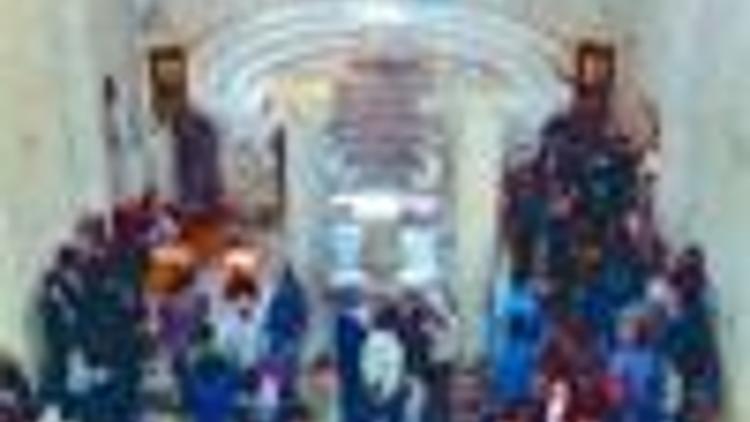Myra, home to the Church of St Nicholas
Güncelleme Tarihi:

ANTALYA - Myria, one of the five most important cities of ancient Lycia in Mediterranean, is of great importance to the Christian world.
Home to the Church of St. Nicholas, and regarded as the protector of the seas, children and travelers, Myria attracts millions of visitors from all over the world every year. St Nicholas is commemorated Dec 6 when ceremonies are held in his memory and presents are given to children.
Myra, located between Finike and Kaş in southern Turkey, was one of the five most important cities of ancient Lycia. Dating back to the fifth century B.C., excavations show that Myra used to be an elegant city. Today it is a small district formed by a merger of three smaller districts.
Myra is a focal point of Turkey’s natural beauties, historical artifacts and splendid sea, and also the closest exit to the Kekova Gulf. Located between the outskirts of the Taurus Mountains and the turquoise Mediterranean Sea, the coastal city captivates domestic and foreign visitors with the scent of lemon and orange trees in the spring.
Significant for ancient graves and theaters from the Lycia civilization, Myra is also of great importance to the Christian world. Home to the Church of St. Nicholas, regarded as the protector of the seas, children and travelers, Myra attracts millions of visitors from all over the world every year.
Santa Claus
St. Nicholas, later known as Santa Claus, was born the son of an affluent wheat merchant in Patara, one of the important Lycia cities on Turkey’s Mediterranean coast that neighbors Myra. It is believed he came to the world as the savior of the poor and a present from the sky to his parents. Creating miracles even in his youth, Nicholas inherited a large sum of money upon the death of his father. Nicholas became renowned among the people for deciding to spend his fortune helping those in need.
In the meantime, a resident of Patara, who used to be a rich man, lost all his money and could not afford to raise a dowry for his daughters. When he began to think he should sell his daughter, Nicholas decided to help the family. So as not to wound the father's pride, Nicholas entered the house at night through an open window and left a pouch of gold to provide the dowry for his eldest daughter, thus saving the family.
Later, Nicholas wanted to help the younger daughters with their weddings and threw a similar sum of gold down the chimney because the windows were closed. Here lie the origins of the story of Santa Claus’ sliding down chimneys to leave presents on Christmas Eve.
An alternative story for the origins of Santa Claus is this: Nicholas went to Jerusalem to become a Christian pilgrim. On his return, he saved a ship that was almost wrecked during a terrible storm and resuscitated a seaman who had nearly drowned after falling into the sea. It is said he saved the sailors with his prayers and as of that day, Nicholas has also been regarded as the patron saint of mariners.
Nicholas moved to Myra and became the archbishop. Continuing to perform miracles by saving the poor and revitalizing the dead, Nicholas remained in Myra until he died at the age of 65 in A.D. 326. The residents of Myra built a church commemorating him and placed him in a tomb inside for his eternal sleep.
During the crusades, merchants stole his remains and buried them in a basilica they had built. St. Nicholas’s remaining bones are exhibited in the Antalya Museum today.
St. Nicholas is commemorated Dec. 6, when ceremonies are held in his memory and presents are given to children. Moreover, a Santa Claus Symposium is held in Antalya and is attended by many ecclesiastics and scientists from all over the world. Calls for peace, friendship and brotherhood for all people, regardless of religion, are repeated at the annual symposium.
Holland’s Sinterkoas, France’s Pere Noel, England’s Father Christmas and America’s Santa Claus stories all derive from St. Nicholas.
Church of St Nicholas
When the church built following the death of St. Nicholas was demolished in the earthquake of 529, a bigger one in the style of a basilica was built. The new church was also damaged by Arab invasions and earthquakes in the eighth and 11th centuries. An inscription reveals that the church was renovated by Constantine Monomakhos IX, who was a Byzantium emperor, and his wife, Zöe.
The Turks took possession of Myra in the 13th century and used the church for prayers after overhauling some sections. At the time of the Kırım War in 1853, the Russians became interested in the church and bought land to colonize the area. Understanding the real intent behind this purchase, however, the Ottoman Empire took back the land, only accepting the request to repair the church. In 1862, French August Salzmann was appointed for this task, but the restoration was so badly performed that the original form of the church was distorted. The freestanding bell tower was added during these restorations.

